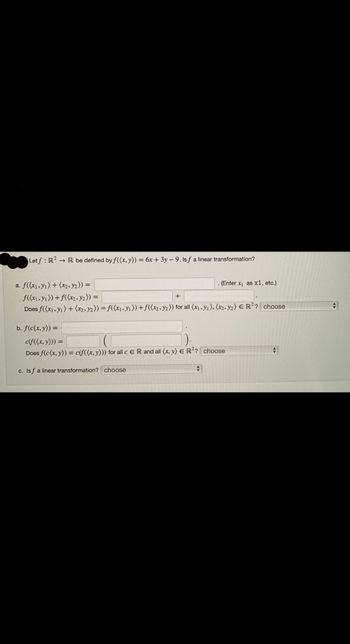
Advanced Engineering Mathematics
10th Edition
ISBN: 9780470458365
Author: Erwin Kreyszig
Publisher: Wiley, John & Sons, Incorporated
expand_more
expand_more
format_list_bulleted
Question

Transcribed Image Text:Letf: R2 R be defined by f((x, y)) = 6x + 3y - 9. lsf a linear transformation?
a. f((x₁, y₁) + (x2, y₂)) =
f((x₁, y₁)) + f((x2, y2)) =
+
Does f((x₁, y1) + (x2, y2)) = f((x₁, y₁)) + f((x2, y2)) for all (x₁, y₁), (x2, y2) E R²? choose
. (Enter x₁ as x1, etc.)
b. f(c(x, y)) =
c(f((x, y))) =
Does f(c(x, y)) = c(f((x, y))) for all c ER and all (x, y) E R²? choose
c. Isf a linear transformation? choose
Expert Solution
This question has been solved!
Explore an expertly crafted, step-by-step solution for a thorough understanding of key concepts.
Step by stepSolved in 2 steps with 2 images

Knowledge Booster
Similar questions
- Let f: R²R be defined by f((x, y)) = 8y - 4x + 1. Is ƒ a linear transformation? a. f((x1, y₁) + (x2, Y2)) (Enter x₁ as x1, etc.) f((x₁, y₁)) + f((x2, y₂)) = + Does f((x1, y₁) + (x2, 2)) = f((x₁, y₁)) + f((x2, ₂)) for all (x1, y₁), (x2, Y₂) € R²? choose b. f(c(x, y)) = c(f((x, y))) = Does f(c(x, y)) = c(f((x, y))) for all CER and all (x, y) = R²? choose c. Is f a linear transformation? choosearrow_forwardLetf: R2 → R be defined by f((x, y)) = 7x + 7y + 1. Isf a linear transformation? a. f((x₁, y₁) + (x₂, y₂)) = b. f(c(x, y)) = f((x₁, y₁)) + f((x2, y₂)) = + Does f((x₁, y1) + (x₂, y₂)) = f((x₁, y₁)) + f((x2, y2)) for all (x₁, y₁), (x2, y2) ER2? choose . (Enter x₁ as x1, etc.) c(f((x, y))) = Does f(c(x, y)) = c(f((x, y))) for all c ER and all (x, y) = R²? choose c. Is f a linear transformation? choose Note: In order to get credit for this problem all answers must be correct. →arrow_forwardLetf: R² → R be defined by f((x, y)) = -6x - 8y. Isf a linear transformation? a. f((x₁, y₁) + (x2, y₂)) = b. f(c(x, y)) = f((x₁, y₁)) + f((x₂, y₂)) = + Does f(x,y1) + (x₂, y2)) =f((x₁, y₁)) + f((x2, y2)) for all (x₁, y₁), (x₂, y2) E R²? choose (Enter x₁ as x1, etc.) c(f((x, y))) = Does f(c(x, y)) = c(f((x, y))) for all c ER and all (x, y) E R²? choose c. Isf a linear transformation? choose + + +arrow_forward
- Find 11 (3 (3x + 2y)dA where R is the parallelogram with vertices (0,0), (4,5), (-3,1), and (1,6). Use the transformation = 4u - 3v, y = 5u + v.arrow_forwardLet f: R R be defined by f((x, y)) = 7y - 3x - 3. Is f a linear transformation? a. f((x₁, y₁) + (x₂, y₂)) = etc.) f((x₁, y₁>) + f((x₂, y₂)) = + Does f((x1, y₁) + (x2, Y2 )) = f ((x₁, y₁ )) + f((x2, Y₂ )) for all (x₁, y₁), (x2, Y₂) E R ²? choose b. f (c(x, y)) = c(f((x, y))) = Does f(c(x, y)) = c(f ((x, y))) for all c ER and all (x, y) ER ²? choose c. Is f a linear transformation? choose . (Enter x₁ as x1, <arrow_forward
arrow_back_ios
arrow_forward_ios
Recommended textbooks for you
 Advanced Engineering MathematicsAdvanced MathISBN:9780470458365Author:Erwin KreyszigPublisher:Wiley, John & Sons, Incorporated
Advanced Engineering MathematicsAdvanced MathISBN:9780470458365Author:Erwin KreyszigPublisher:Wiley, John & Sons, Incorporated Numerical Methods for EngineersAdvanced MathISBN:9780073397924Author:Steven C. Chapra Dr., Raymond P. CanalePublisher:McGraw-Hill Education
Numerical Methods for EngineersAdvanced MathISBN:9780073397924Author:Steven C. Chapra Dr., Raymond P. CanalePublisher:McGraw-Hill Education Introductory Mathematics for Engineering Applicat...Advanced MathISBN:9781118141809Author:Nathan KlingbeilPublisher:WILEY
Introductory Mathematics for Engineering Applicat...Advanced MathISBN:9781118141809Author:Nathan KlingbeilPublisher:WILEY Mathematics For Machine TechnologyAdvanced MathISBN:9781337798310Author:Peterson, John.Publisher:Cengage Learning,
Mathematics For Machine TechnologyAdvanced MathISBN:9781337798310Author:Peterson, John.Publisher:Cengage Learning,


Advanced Engineering Mathematics
Advanced Math
ISBN:9780470458365
Author:Erwin Kreyszig
Publisher:Wiley, John & Sons, Incorporated

Numerical Methods for Engineers
Advanced Math
ISBN:9780073397924
Author:Steven C. Chapra Dr., Raymond P. Canale
Publisher:McGraw-Hill Education

Introductory Mathematics for Engineering Applicat...
Advanced Math
ISBN:9781118141809
Author:Nathan Klingbeil
Publisher:WILEY

Mathematics For Machine Technology
Advanced Math
ISBN:9781337798310
Author:Peterson, John.
Publisher:Cengage Learning,

